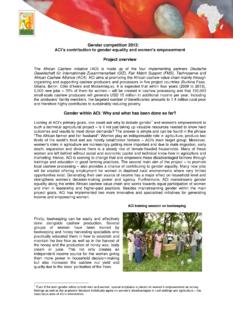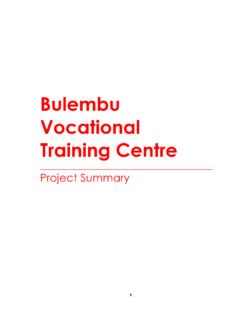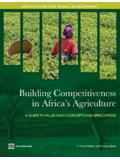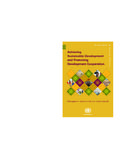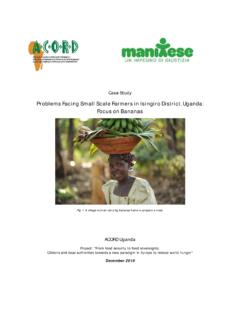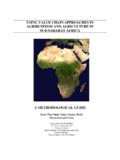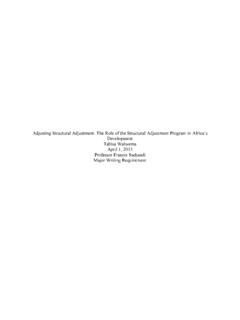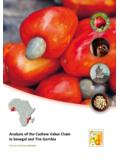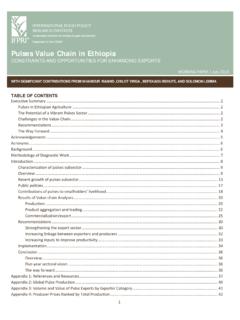Transcription of AGRICULTURAL MANAGEMENT, MARKETING AND …
1 AGRICULTURAL management , MARKETING AND finance WORKING DOCUMENT 23 Agro-industries characterization and appraisal: Asparagus in Peru AGRICULTURAL management , MARKETING AND finance WORKING DOCUMENT 23 Agro-industries characterization and appraisal: Asparagus in Peru by Luz D az Rios AGRICULTURAL management , MARKETING and finance Service (AGSF) Rural Infrastructure and Agro-Industries Division FOOD AND AGRICULTURE ORGANIZATION OF THE UNITED NATIONS Rome, 2007 The views expressed in this publication are those of the author(s) and do not necessarily reflect the views of the Food and Agriculture Organization of the United designations employed and the presentation of material in this informationproduct do not imply the expression of any opinion whatsoever on the partof the Food and Agriculture Organization of the United Nations (FAO) concerning thelegal or development status of any country, territory, city or area or of its authorities, or concerning the delimitation of its frontiers or boundaries.
2 The mention of specificcompanies or products of manufacturers, whether or not these have been patented, doesnot imply that these have been endorsed or recommended by FAO in preference toothers of a similar nature that are not rights reserved. Reproduction and dissemination of material in this informationproduct for educational or other non-commercial purposes are authorized withoutany prior written permission from the copyright holders provided the source is fullyacknowledged. Reproduction of material in this information product for resale or othercommercial purposes is prohibited without written permission of the copyright for such permission should be addressed to:ChiefElectronic Publishing Policy and Support BranchCommunication DivisionFAOV iale delle Terme di Caracalla, 00153 Rome, Italyor by e-mail FAO 2007 Agro-industries characterization and appraisal: Asparagus in Peru iiiContentsPreface vacknowledgements viiacronyms ix1.
3 DeveloPment of the asParagus industry in Peru 1 Historical perspective 1 opportunities for expansion 22. Performance of the Peruvian asParagus industry on the global stage 5 consolidation of tHe asparagus industry: tHe export boom 5 market destinations for peruvian asparagus exports 7 tHe world s asparagus suppliers 103. key elements of success: develoPment of comPetitive advantages 13 increased productivity 13 compliance witH sanitary and pHytosanitary requirements 16 approacHes to quality and safety issues 19 Horizontal coordination to reduce inefficiency and costs 224. analysis of the Peruvian asParagus value chain 25 tHe industry actors 25 coordinating mecHanisms: producer buyer linkages 29 logistics costs 31 social impact 36 government strategies to improve export competitiveness 375. the challenges ahead 41 expansion of tHe agro-export frontier 41 consolidation of export volumes 43 market expansion tHrougH innovations 43 coordination of tHe public and private sector 44annex 1 47 tHe world s main players in fresH asparagus international trade 47annex 2 49 tHe world s main players in processed asparagus international trade 49annex 3 51 tHe main destination markets for peruvian asparagus (fresH, processed, frozen) 51annex 4 53 peruvian asparagus industry: swot analysis 53references 55list of tablestable 1.
4 Asparagus production in tHe top eigHt producing countries (in percentages) 6table 2. main asparagus exports in tHe world (2005) 10table 3. price structure of fresH asparagus exported to tHe united states (miami, florida) 32list of figuresfigure 1. geograpHical distribution of cultivated land devoted to asparagus (2004) 3figure 2. tHe evolution of peruvian asparagus exports (us$ fob) 5figure 3. united states fresH asparagus imports 8figure 4. major suppliers sHare of fresH asparagus in tHe united states market by quantity 8figure 5. peruvian non-traditional exports to tHe eu (above us$15 million -2005) 9figure 6. worldwide estimated Hectares of asparagus production in 1997, 2001 and 2005 13figure 7. peru: asparagus production vs. area in Hectares (1995-2005) 14figure 8. evolution of asparagus yields: peru vs world 15figure 9. yield/Hectare: eigHt major asparagus-producing countries (2005) 16figure 10. companies sHare of tHe total asparagus export value, 2005 (us$ fob) 26figure 11.
5 Access to credit 29figure 12. air and maritime transportation for fresH asparagus (in percentages) 31figure 13. port costs 32figure 14. participation of non-traditional agriculture in total AGRICULTURAL production 34figure 15. geograpHical distribution of peruvian agro-export production areas 35figure 16. market destinations for non-traditional exports (2005) 35iv ContentsAgro-industries characterization and appraisal: Asparagus in Peru vPrefacePeru has recently benefited from the strong global demand for commodities. The continuing favourable outlook for global commodity prices provides an extraordinary opportunity for Peruvian policy-makers in further supporting the consolidation of the non-traditional export sector to generate growth, reduce poverty, and social inequalities and avoid vulnerabilities associated with dependence on traditional exports. Diversification of exports has been a high priority for the Peruvian Government since the mid-1990s, emphasized by the policies put in place during President Toledo s administration.
6 Non-traditional agriculture exports have expanded and diversified significantly in recent years, reaching a value of US$ billion in 2005. In the years 2000-2005 the sector grew at an average annual rate of nearly 20 percent, led by the astonishing growth of high added-value export products. Asparagus exports rank at the top, with a 25 percent share of the total value of non-traditional exports in s asparagus industry enjoys a privileged position in international markets resulting from private and public efforts to develop competitive advantages within the framework of strong international competition, strict sanitary and phytosanitary market access requirements, growing private demands for high-quality and safe produce, and traceability asparagus industry has certainly been an engine for economic growth, reflected in its contribution to the generation of export revenues and employment.
7 This study is aimed at analysing the institutional, structural, and policy factors related to the development of the industry. It addresses the opportunities, including those for smallholder horticulture enterprises, and the possible challenges that may impede or foster the industry s long-term competitiveness and sustainability. The study is based on the qualitative and quantitative data collected from informal interviews with key actors and informants, available secondary data and information collected during the author s participation in the 3rd Asparagus Technical Congress held in Lima, Peru, in July study begins with a brief historical perspective on the development of the industry, followed by an overview of the performance of the Peruvian asparagus industry on the global stage, highlighting key elements that have contributed to the development of competitive advantages.
8 This is followed by a general analysis of the asparagus value chain, describing actors, interactions and bottlenecks to competitiveness, and the participation of small and medium-scale horticulture enterprises. Finally, the challenges ahead for the industry to achieve long-term sustainability are working document is aimed at those working at ministries of agriculture and extension services, Non-Governmental Organizations (NGOs) and related projects concerned with AGRICULTURAL characterization and appraisal: Asparagus in Peru viiAcknowledgementsThe author would like to thank the following Peruvian leaders of the asparagus industry, producers, association representatives and public and private authorities for their valuable contributions to the preparation of this report. Viviana Mok Calle, Specialist, Plant Quarantine Section, Plant Health Division. National Agrarian Health Service, (SENASA).
9 Jorge Barrenechea Cabrera, Plant Health General Director, National Agrarian Health Service, (SENASA). Pablo Aramburu Yrigoyen, Adviser, Ministry of Agriculture. Fausto Robles Rodriguez, Agro and Agro-industry Manager, Peruvian Export Promotion Agency (PROMPEX). Jos Ordonez Chavez, Agro-exports Manager, Exporters Association of Peru (ADEX). Sandro Farf n Padilla, Manager, Asociaci n de Gremios Productores y Exportadores del Per (AGAP). Paula Ramirez Garc a, Executive Director, Food Hygiene and Zoonosis, General Directorate of Environmental Health (DIGESA), Ministry of Health. Jose Chlimper, Manager, Sociedad Agr cola Drokasa (AGROKASA) Eduardo Ezeta, Technical Department, SGS of Peru. Raul Juscamaita, Senior Coordinator, SGS of Peru. Marcela Benavides de Burga, Competitiveness Support Programme, Andean Development Corporation (CAF). Arturo Rosadio Quevedo, Business Development Manager, TechnoServe and Director of Agronegocios ARQ.
10 Marly L pez Rengifo, Specialist, Direcci n General de Promoci n Agraria. Ministry of Agriculture. Edgard del guila Hoyos, Director de Cultivos de la Direcci n General de Promoci n Agraria, Ministry of Agriculture. Beatriz Tubino Bardales, Manager, the Peruvian Asparagus and Vegetables Institute (IPEH). Ricardo Bustamante Cilloniz, Manager, Fundo San Fernando. Roberto Carlos Flores, Technical Staff, Green Peru. Centre for the Promotion of Small and Medium-sized Enterprises of Peru (PROMPYME), Proyecto Generando Capacidades para las Cadenas de Exportaci n-(GEXCE):- Christian Rodriguez Ramos- Allen Fernando Concha- Raquel Rebolledo Andrea BarracoAn additional thank you also goes to Doyle Baker, Chief, AGRICULTURAL management , MARKETING and finance Service, for his support and advice. David Kahan, Senior Officer, for his review of the document, Martin Hilmi, for editing and for following the publication process, Marianne Sinko, for the layout and desktop characterization and appraisal.










